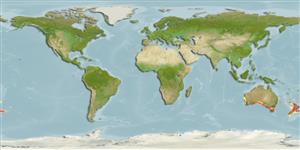Environment: milieu / climate zone / depth range / distribution range
Ecologie
marien demersaal; diepte 50 - 750 m (Ref. 6390). Subtropical; 26°S - 55°S
Southwest Pacific: Australia and New Zealand. Two forms of ocean perch are recognized in waters off New South Wales, Australia (Ref. 6390). They are referred to as 'inshore' and 'offshore' forms based on their preferred depth ranges (Ref. 6390).
A closely related species, Helicolenus barathri, is known from New Zealand and its distribution may also include southern Australian waters (Ref. 30468, 30471).
Grootte / Gewicht / Leeftijd
Maturity: Lm ? range ? - ? cm
Max length : 47.0 cm TL mannelijk / geslacht onbekend; (Ref. 9563); max. gepubliceerd gewicht: 1.4 kg (Ref. 30476); max. gerapporteerde leeftijd: 42 Jaren (Ref. 30476)
Dorsale stekels (totaal): 12; Dorsale zachte stralen (totaal): 11-12; Anale stekels 3; Anale zachte stralen: 5; Wervels: 25
Occur on the continental shelf and slope (Ref. 9563). Two forms exist in New South Wales, Australia. The inshore form is dominant in depths less than 300 m and the offshore form is most common in deeper waters (Ref. 30468). Juveniles of both forms are caught near the edge of the continental shelf by fishers targeting royal red prawns (Haliporoides sibogae) in Australia, but their full distribution is unknown (Ref. 6390). Reproduction in ocean perch is distinctive in that fertilization is internal (Ref. 6390, 34817). Feed on squid, shrimps and fish (Ref. 6390). Head and dorsal-fin spines are venomous (Ref. 33616). Sold whole and chilled on the domestic fresh fish markets (Ref. 6390).
Larvae stay within the female fish until they are approximately 1 mm long before they are released into the water (Ref. 6390).
In Australia, the inshore and offshore forms of ocean perch begin mating at different times and there is a difference in the length of their larval development prior to release (Ref. 30468).
Kailola, P.J., M.J. Williams, P.C. Stewart, R.E. Reichelt, A. McNee and C. Grieve, 1993. Australian fisheries resources. Bureau of Resource Sciences, Canberra, Australia. 422 p. (Ref. 6390)
Status op de Rode Lijst van het IUCN (Ref. 130435)
Gebruik door de mens
Visserij: commercieel
Meer informatie
ReferentiesAquacultuurAquacultuurprofielKweeklijnenGeneticaElectrophoresesErfelijkheidZiektesVerwerkingNutrientsMassaconversie
Tools
Speciale rapporten
Download XML
Internetbronnen
Estimates based on models
Preferred temperature (Ref.
123201): 10.5 - 16.6, mean 13 °C (based on 72 cells).
Fylogenetische diversiteitsindex (Ref.
82804): PD
50 = 0.5020 [Uniqueness, from 0.5 = low to 2.0 = high].
Bayesian length-weight: a=0.01622 (0.00974 - 0.02701), b=3.12 (2.97 - 3.27), in cm total length, based on LWR estimates for this species & (Sub)family-body (Ref.
93245).
Trofisch niveau (Ref.
69278): 3.9 ±0.6 se; based on diet studies.
Weerstandsvermogen (Ref.
120179): laag, minimale populatieverdubbelingstijd 4,5-14 jaar (K=0.11-0.12; tmax=42; Fec=150,000).
Fishing Vulnerability (Ref.
59153): High vulnerability (64 of 100).
Nutrients (Ref.
124155): Calcium = 59 [20, 156] mg/100g; Iron = 1.05 [0.46, 2.21] mg/100g; Protein = 17.9 [16.3, 19.7] %; Omega3 = 0.643 [0.281, 1.641] g/100g; Selenium = 42.5 [18.9, 115.9] μg/100g; VitaminA = 24.5 [8.1, 78.9] μg/100g; Zinc = 0.671 [0.378, 1.054] mg/100g (wet weight);
